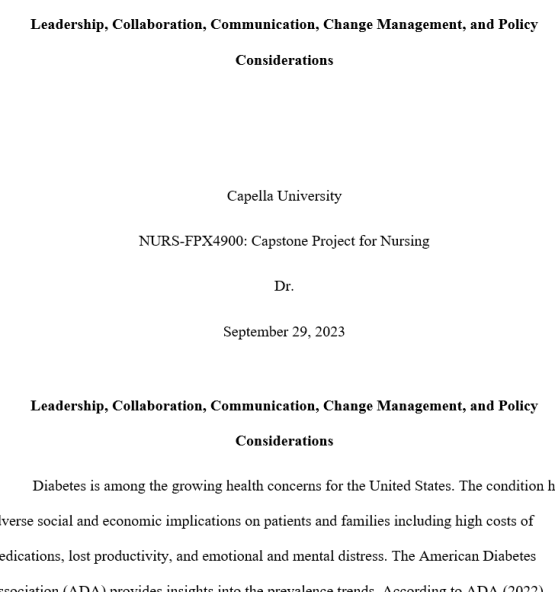


Leadership, Collaboration, Communication, Change Management, and Policy Considerations
Capella University
NURS-FPX4900: Capstone Project for Nursing
Dr.
September 29, 2023
Availability:In Stock
Diabetes is among the growing health concerns for the United States. The condition had adverse social and economic implications on patients and families including high costs of medications, lost productivity, and emotional and mental distress. The American Diabetes Association (ADA) provides insights into the prevalence trends. According to ADA (2022), about 37.3 million Americans have diabetes, with type 2 diabetes accounting for the largest number. The rate of undiagnosed diabetes is also high at about 8.5 million. The association also indicates that there are about 1.4 million new cases annually, while about 96 adults have prediabetes (ADA, 2022). Health disparities are also visible with populations such as African Americans, non-Hispanic blacks, Hispanics, and American Indians being some of the most affected groups. Estimated yearly costs of $327 billion demonstrate the need for the nation to focus more on early prevention and treatment. Increased health education and promotion is necessary to encourage individuals to adopt the right behaviors, attitudes, and values. The practices include adopting self-care activities such as tobacco smoking cessation, exercise, and healthy diet to prevent symptoms from escalating to uncontrollable levels.
Additionally, culturally and linguistically appropriate interventions are necessary to deliver services that match individuals’ values and preferences. In this sense, everyone gets the opportunity to access accurate and complete information on mechanisms for preventing and controlling symptoms. Vulnerable populations with limited access to screening, diagnosis, and treatment can benefit from proactive efforts to address disparities and protect them from the adverse impacts of diabetes (Alshammari et al., 2020). Collaborative efforts among different healthcare professionals strengthen efforts to design and implement practices that match determinants of health at the community level. The various providers dedicate time and energy towards educating, training and following up to enable patients and their families manage diabetes and related complications. Similarly, nurses’ frontline roles allow them to make informed decisions on patients’ demands including calls for patient-centered and evidence-based interventions. Utilizing credible and reliable evidence from peer-reviewed journal articles and professional websites such as the American Diabetes Association guides healthcare professionals to make informed conclusions about diabetes trends and appropriate solutions.
The Healthy People 2030 clarifies the need for increased efforts to reduce the burden of diabetes. The policy reminds health care leaders to play active roles in improving quality of life for everyone living with or at risk of the condition. With over 30 million people living with diabetes and the disease being the seventh cause of death among American adults, leaders should focus more on reducing cases, complications, and mortality threats (ODPHP, 2022). Leaders use their knowledge and skills to respond to disparities that expose patients to the risks of amputations, vision loss, and kidney damage. Adherence to recommendations from Healthy People 2030 guides leaders to initiate solutions for increasing the number of people seeking early diagnosis, formal diabetes education, and advice on self-monitoring of blood glucose levels.
Change is necessary to reduce diabetes burden across communities. The process requires sound leadership characterized by the ability to inspire a shared vision for diabetes screening and control. The leader also gets support from staff to enable them highlight the need for new programs such as scaled diabetes education and promotion (Petersen et al., 2021). For best outcomes, systematic change management should form an inherent part of every organization. Shared governance is among the best options for leaders to allow everyone to measure change. The process entails collective efforts to embrace positive attitude necessary to respond to the needs and expectations of different patients and families. For successful change, leaders should determine health barriers that influence access to screening, prevention, and control programs (Szafran et al., 2019).
The leaders also assess determinants of health in communities to enable them identify resources limitations and efforts necessary to scale prevention and control. For instance, leaders access health literacy levels to make informed conclusions on the need for education seminars to increase awareness about diabetes. The goal is to initiate strategies, including media campaigns that support lifestyle changes such as increased exercise, weight management, and self-monitoring of blood glucose levels.
Change management for diabetes prevention and control entails active collaborations between local clinics, the health department, and other institutions. The stakeholders help health care leaders reassess determinants of health and the steps necessary to improve outcomes. The various changes capture the relevance of transformational leadership approaches in facilitating reduction of health barriers and initiating new programs including follow-ups to strengthen prevention and control (Szafran et al., 2019). With uncertainties surrounding health budgets, it is evident that good leaders could help improve access to education and prescription drugs to safeguard patients from the adverse impacts of diabetes-related complications. The transformational leader provides opportunities for individuals and teams to learn and develop alternatives for responding to the needs and expectations of diabetes patients. The leader encourages interdisciplinary practices for individuals to learn from one another and develop innovative care across the continuum. Thus, health care leaders should lead the planning of reforms meant to deliver quality, innovative, and safe care.
Reviews
There are no reviews yet.